Skip to content Writing assistance: Creating briefs or other content, editing, reviewing or summarizing text, or generating new tables.Knowledge assistance: Answering questions, finding content, or getting specific insights from data (granular and high-level).Task assistance: Generating a holistic AI solution that connects to other tools and can perform tasks at scale.
Writing assistance: Creating briefs or other content, editing, reviewing or summarizing text, or generating new tables.Knowledge assistance: Answering questions, finding content, or getting specific insights from data (granular and high-level).Task assistance: Generating a holistic AI solution that connects to other tools and can perform tasks at scale.
Using AI to create content for briefs, reports, writeups, blogs, retros and more. Getting help across the writing process, from first draft to final version. Generating new tables, such as a table of potential names for a new feature, or a table of potential metrics and their definitions.
Creating new content: Atlassian Intelligence can best help when you are starting with a blank page, or have existing notes on a page that you’d like to turn into a first draft. It can create simple tables, like what you can generate in Powerpoint. Creating content based on other context: The AI prompt can’t look at context outside of the page. For example, if you are trying to write a product brief based on personal notes, meeting notes, and customer feedback, you’d need to copy/paste onto one page.Brainstorming and editing: The interface makes it difficult. You can’t actively collaborate with Atlassian Intelligence, and the surface is limited for viewing suggested edits. Sharing feedback: Atlassian Intelligence can only share feedback within the limited prompt box, making it hard to understand how and where to apply the feedback.
Creating new content: Coda AI can also help you start from scratch, using any prompt. Coda AI can also generate complex tables, which means you can add functionality like voting, or quickly turn the table into a chart. Creating content based on other context: Coda AI lets you @ reference any pages or tables across your doc as context. For example, if you are writing a product brief, you can specify which pieces of customer feedback or discussion notes are relevant for the first draft. Brainstorming and editing: Coda AI can have a dialogue with you in the side panel. So you can ask for five more versions of a sentence (and five more after that), and then pick your favorite.Sharing feedback: Coda AI reviewer also leaves comments with feedback, so feels like a helpful team collaborator, and makes it easy to tag others with questions and ideas.
Getting the insights you need from your data, including answers to specific questions, or AI tags that can create charts and dashboards. Asking questions about your content, like vacation or PTO policies.Finding the resource you need, such as a link to the image library or latest meeting notes.
Answering questions: Atlassian Intelligence can answer questions based on your team’s content across different docs and pages. It provides summarized answers, and then lists resources, similar to a search engine. Creating fresh summaries: It can also provide one-click summaries of published pages. Generating dashboards: Atlassian Intelligence can’t create tags, sentiment, or summaries for each row.
Answering questions: Coda AI can answer any questions about content across your doc, and provide links to pages with more information. Creating fresh summaries: Coda AI has AI blocks that can give more than just the latest summary—no matter where the source data lives across your doc. Generating dashboards: Coda AI can generate tags, text, sentiment, and more for each row—so you can do much more with your data, such as quickly build dashboards.

Ability to build a holistic AI solution that connects to other tools and can perform tasks at scale.Bringing content in from other tools, and using AI to gain insights. Generating updates and messages you can send to other tools, keeping one source of truth.
Getting insights from data in other tools: Confluence mostly serve as live embeds of external sources, which means you often can’t sync in data, and therefore can’t use Atlassian Intelligence to get insights.Sending AI-generated content to other tools: Confluence applications are unable or make it difficult to create a mechanism for sending new content to another tool, such as generating a summary to post in a Slack channel.
Getting insights from data in other tools: Coda’s Pack ecosystem allows you to sync in data from hundreds of tools. Coda AI can then reference the data in these sync tables, making it possible to apply any of the above writing and knowledge assistance examples using this data as context. Sending AI-generated content to other tools: You can add buttons to quickly send content outside of Coda, and automations to do it regularly. This means Coda AI can use data from other tools to generate summaries, insights, or messages, and you can automatically send this content through Slack, Gmail, and Teams, or post updates to Salesforce, Jira and more. Create summaries, that get logged to Salesforce.List action items, to send to Slack.Generate follow-up emails, to send via Gmail.Create follow up agendas for Google Calendar.
The Ultimate Confluence vs Coda Evaluation Guide in 2025
Pages
Note: I asked my colleague Katy to write this page. She’s a Product Marketing Manager on the Coda AI team and has spoken with hundreds of makers about Coda AI.
In 2023, Coda and Confluence launched their AI integrations, allowing you to use AI with the content you already have in each tool.
When Coda first explored building an AI integration, we interviewed teams, executives, and investors, who shared their perspectives on the value of an AI assistant. We then categorized their examples into three types of assistance, which is a lens you should use to evaluate all AI-enabled productivity tools. Given that an AI assistant can provide value in different ways for each team, these three types of assistance provide a broad overview of hundreds of scenarios.
AI that understands your work.
Both Coda AI and Atlassian Intelligence are context aware—meaning AI can use your existing content as context for the prompt. For example, if you are writing a blog, AI can reference your notes, instead of just starting from scratch. However, compared to Atlassian Intelligence, Coda’s and give you much more flexibility with what AI can reference, so its output can be higher quality, and there’s more ways you can use AI to help.
When using Coda AI, you can choose what you want the AI to reference. For example, if you are writing a sales team newsletter, you can @ reference the page with the team meeting notes, the table with synced Salesforce account data, and the page with details about each team member—all in one prompt. This means the AI-generated draft will include this information, making it easier to quickly polish into a final version. When using Atlassian Intelligence, the prompt could not access this context unless it were all on the same page—and you’d likely have to copy and paste from other tools.
Alongside context awareness, it’s helpful to keep in mind factors like user interface, ease of collaborate with AI, or type of content it can create. Let’s dig deeper into how this impacts each tool’s ability to perform the three types of assistance.


1. Writing assistance
Writing assistance includes more than just generating new text on a blank page, but creating informed content you can share, and helping you brainstorm, edit and finalize your work.
Atlassian Intelligence


Atlassian Intelligence can only reference context that’s on the same page.
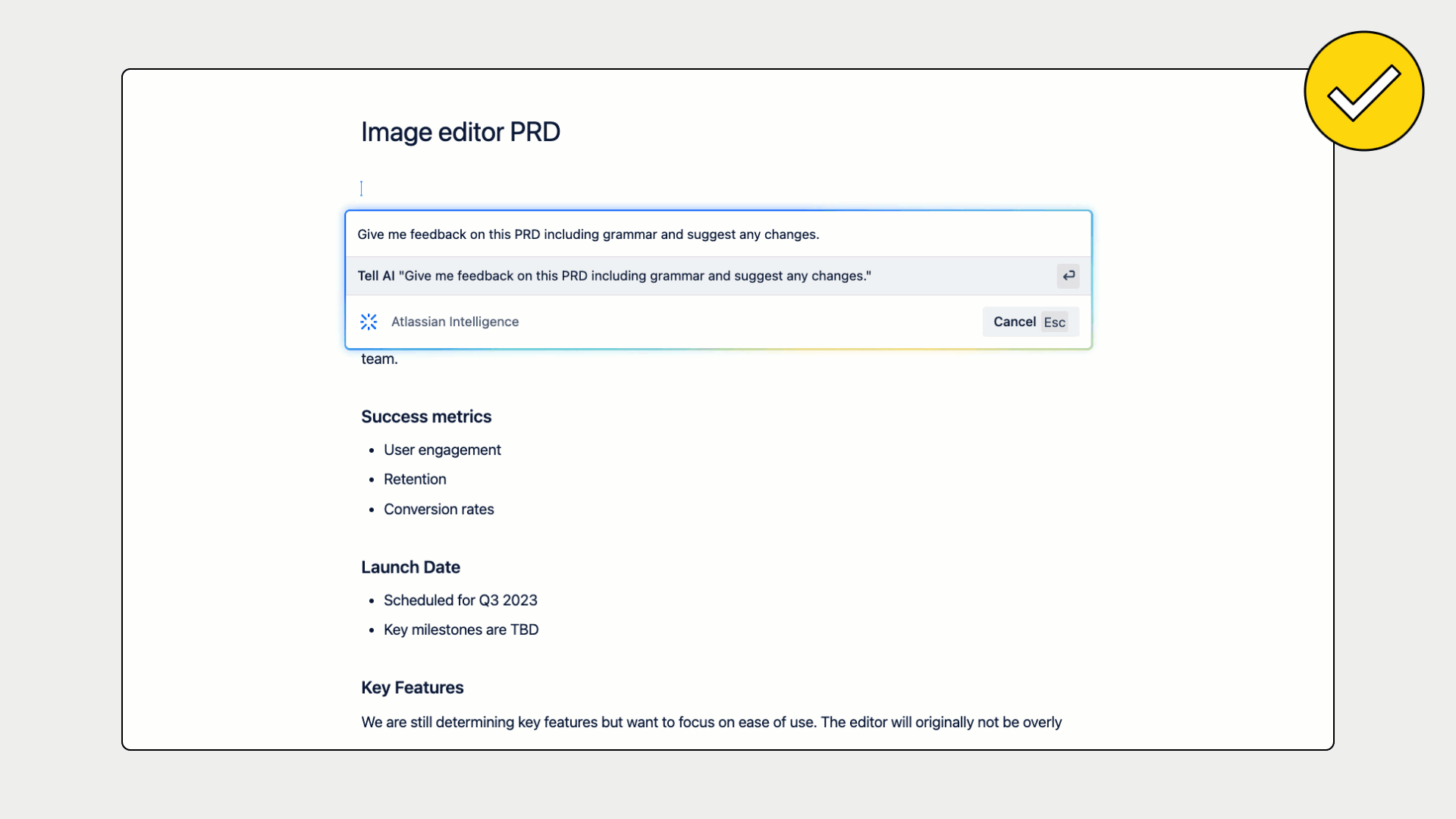

You have to manually cross-reference feedback with your text, and you can’t actively collaborate.
Coda AI


Coda AI can reference any pages and table data, no matter where it lives in the doc. (You can test this prompt
!)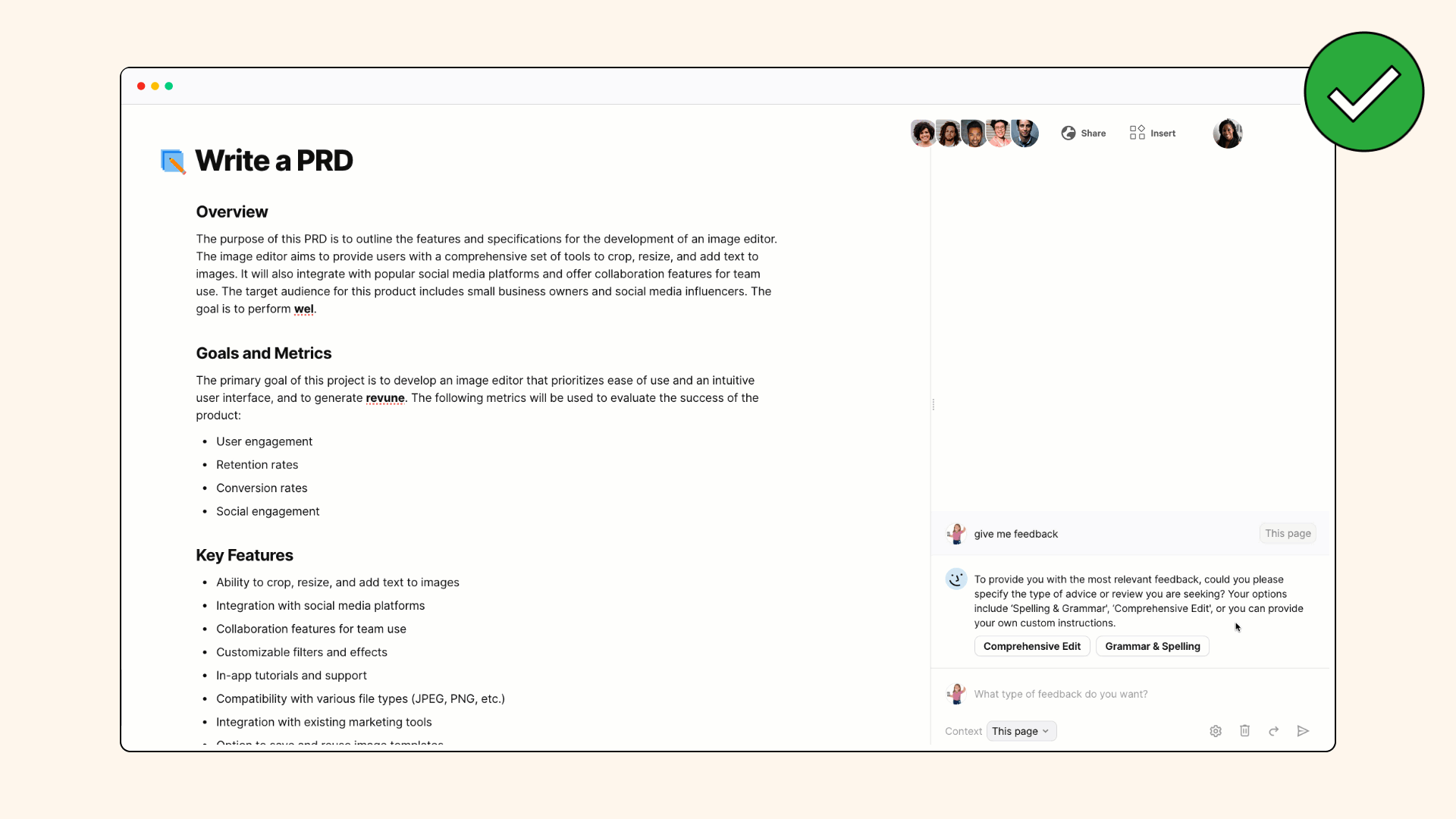

It can also give feedback as targeted comments, so you can easily make changes, or tag a colleague to ask their opinion.
More examples
2. Knowledge assistance
Knowledge assistance includes different types of insights, such as a summary, an ongoing analysis, a quick answer, or simply getting the link you need in the moment.
Atlassian Intelligence


Summarizing and finding information from pages across your space.


One-click summary for published pages—helpful, but a limited insight.


Trying (and not succeeding) to add AI to every row.
Coda AI


Answering questions and sharing links to other pages with more information.
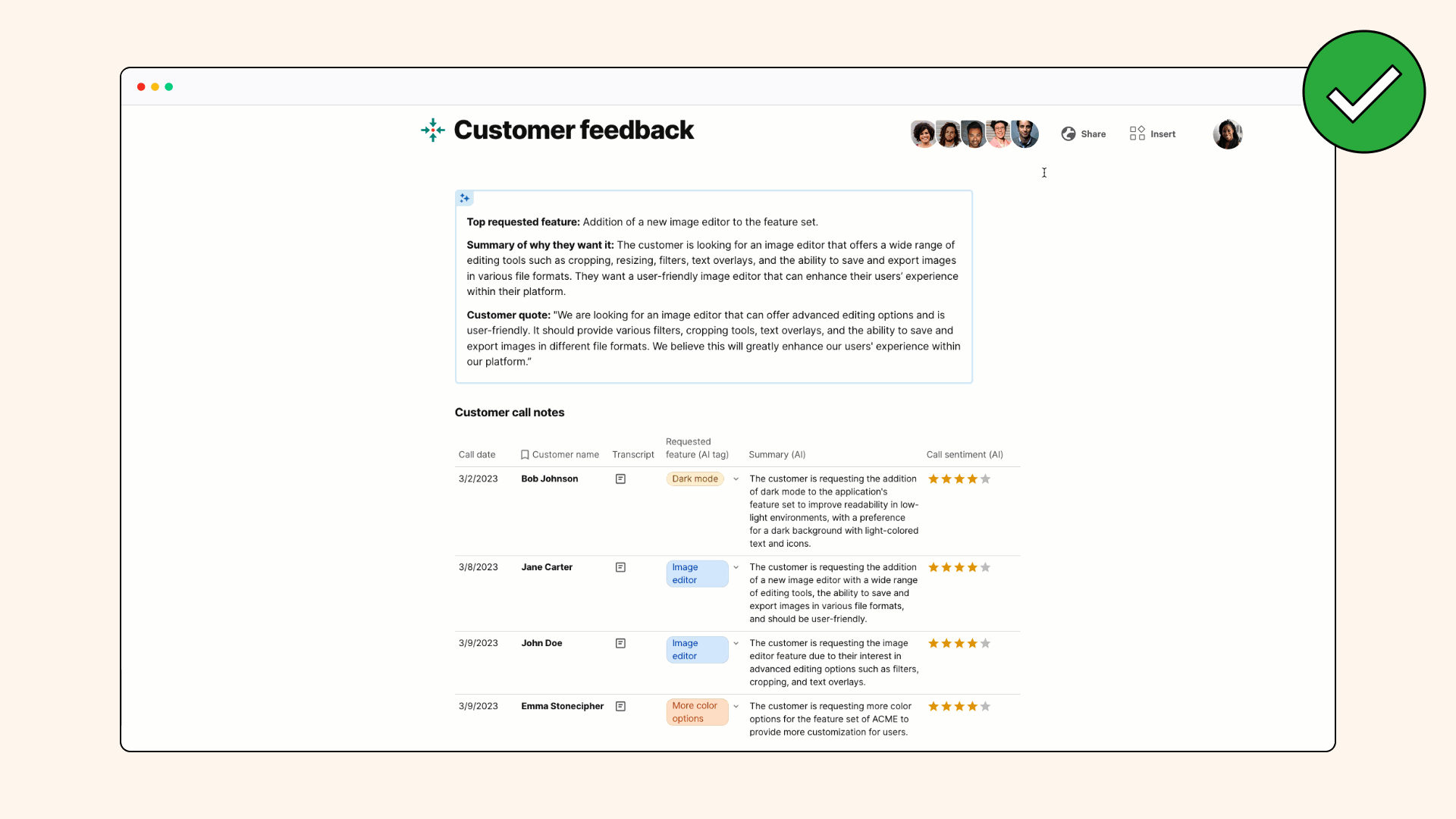

AI blocks that can give more than just a summary, and are easily refreshed.
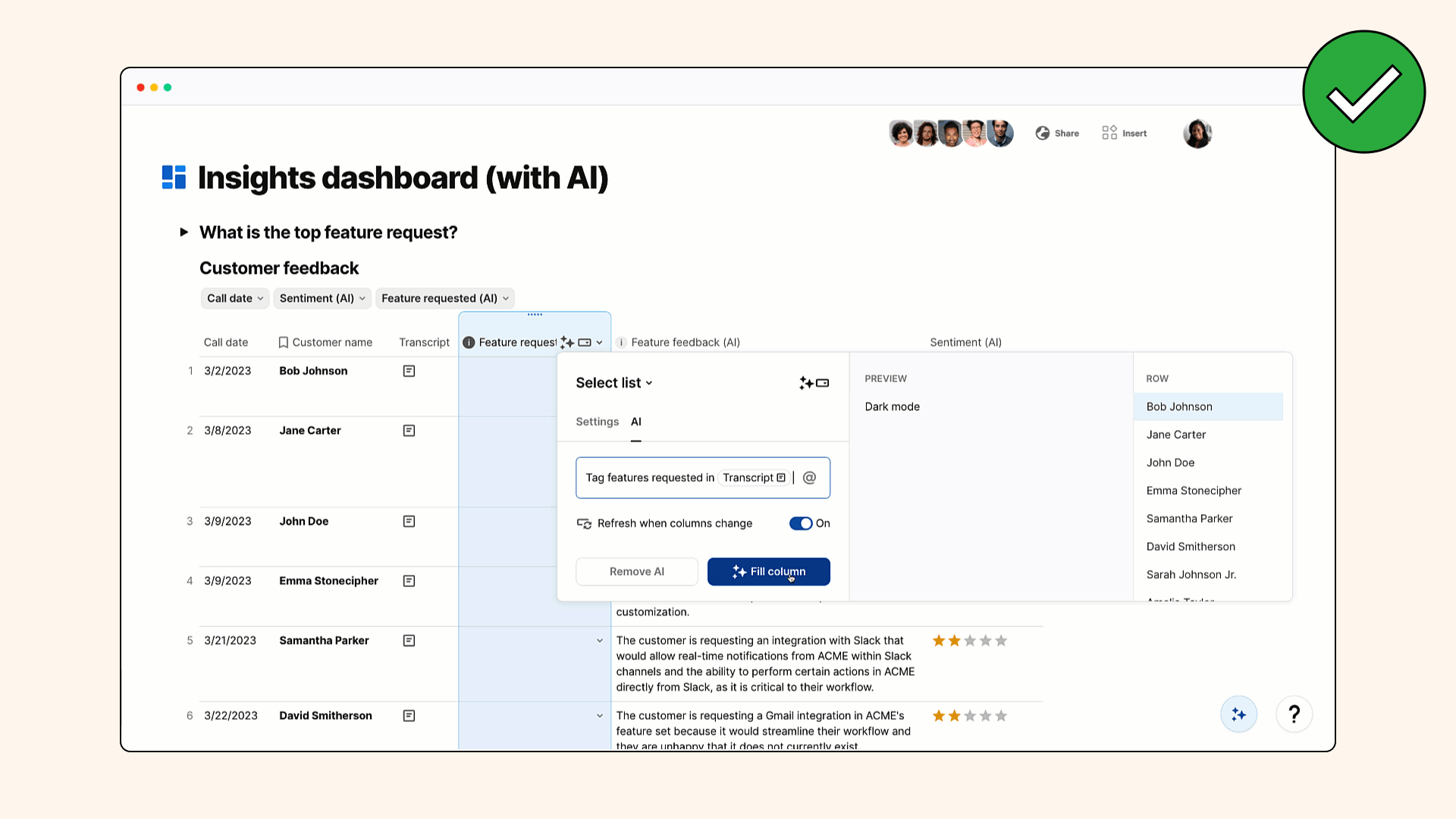

We were sitting on hundreds of customer requests that nobody had ever actually looked at. I created a Jira table sync that pulls in all of the customer tickets... and an AI column to auto-tag all of these issues, like “what’s a hot topic?”
It’s actually been like pretty life changing because, it was just like so much information that I could not deal with on my own.
- Product Manager, Enterprise Customer using Coda AI
3. Task assistance
Task assistance includes more than just accomplishing one small task at a time, but creating an automated solution that allows your team to fully offload a series of items, on an ongoing basis.
Atlassian Intelligence
Coda AI
Coda AI stands out because it can reference information across your doc, including data brought in from other tools, and then create new content you can share inside and outside of Coda, making it a connected AI work assistant.
It’s been really exciting to see how our customers are using Coda AI as a connected AI work assistant to create automated workflows. While this is different for every team, here’s a closer look, using sales and product teams as examples.
An AI solution for sales teams
Based on call notes, Coda AI can:
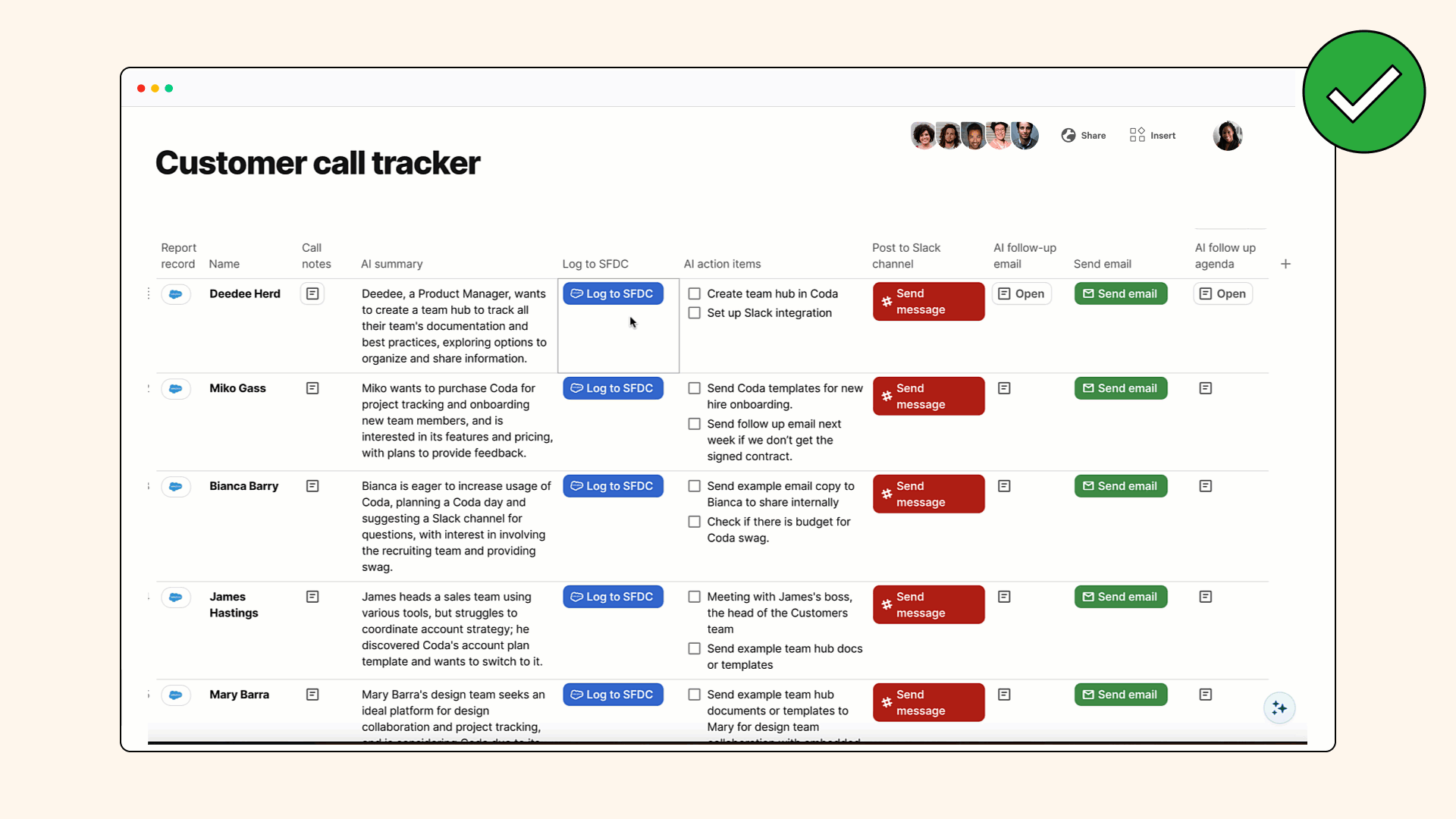

An AI solution for product and engineering teams
Within Coda, you can create Jira issues, tag them, and push updates back to Jira tasks—without paying for extra licenses or bugging a developer.


Answering questions about your Jira issues, or brainstorming next steps.


Generating Issue summaries that can get sent to Slack automatically.
More examples
Other ways Coda AI can integrate with data from other tools to help with your workflows.
More resources
If you would like to further explore Atlassian Intelligence or Coda AI, these resources can help you get started.




Want to print your doc?
This is not the way.
This is not the way.

Try clicking the ⋯ next to your doc name or using a keyboard shortcut (
CtrlP
) instead.